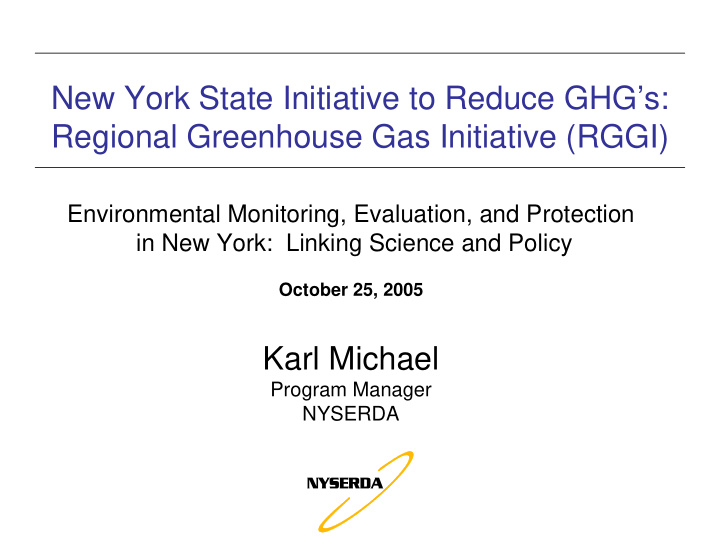



New York State Initiative to Reduce GHG’s: Regional Greenhouse Gas Initiative (RGGI) Environmental Monitoring, Evaluation, and Protection in New York: Linking Science and Policy October 25, 2005 Karl Michael Program Manager NYSERDA
RGGI Process • Gov. Pataki’s April 2003 Invitation • Staff Working Group (SWG) • Stakeholders • SWG Proposal • Agency Heads Meetings • Model Rule and MOU • Rulemaking
RGGI Design Principles • Reduce CO2 with flexible, market- based program to achieve least cost reductions. • Create model for federal program. • Maintain electricity affordability, reliability and fuel diversity. • Make expandable to other states. • Build on programs in place.
Key Elements of RGGI Proposal • Carbon cap – Stabilize emissions through 2015 – Decrease by 10% by 2020 • State CO2 budgets – Based primarily on 2000-2004 emissions • Offsets (Non-electric) – Up to 50% of emissions reductions • 20-25% of State Budget Auctioned – Energy efficiency, new technologies, etc. • Built-in review in 2015 – Price impacts, offsets, imports
NY CO 2 Emissions Trajectories 60 58 56 Millions of Tons CO2 54 52 50 48 Reference 46 Note: unlimited banking allowed Cap Only 44 Package 42 40 2006 2009 2012 2015 2018 2021 2024
NY Generation Mix 200,000 180,000 160,000 140,000 NY GWh 120,000 100,000 80,000 60,000 40,000 20,000 - Ref. 2006 Ref. 2024 Cap Only - 2024 Package - 2024 Nuclear Existing Renewables Coal Oil/Gas Natural Gas (CC&CT) Other - NUG/Cogen New Renewables Net Imports
CO 2 Allowance Prices 9 8 Package 7 Cap Only 6 5 $/Ton 4 3 2 1 0 2006 2009 2012 2015 2018 2021 2024
Change in RGGI Average Annual Energy Prices 6.0% Package 5.0% Change in Energy Price Cap Only 4.0% 3.0% 2.0% 1.0% 0.0% 2006 2009 2012 2015 2018 2021 2024 NOTE: Energy prices represent wholesale market prices and include annualized capacity prices. Note that the RGGI Package Scenario assumes that current levels of annual state expenditures for public benefit programs continue through 2025. While these types of programs cause lower wholesale prices by reducing electricity demand, they are paid for by consumers through a line item charge at the retail level, and are therefore not reflected in the wholesale price changes shown above. Current retail electricity prices already include the annual costs of these programs. While the modeling assumes that end-use energy efficiency is implemented entirely by public benefit programs, it is recognized that energy efficiency could also be implemented by actions such as appliance standards and building codes that do not require state funding and could possibly be done at lower costs.
RGGI Higher Emissions Sensitivities
RGGI Generation Mix Reference v. High Gas v. High Emissions 600 Net Imports 500 Other Renewables 400 Wind Other TWh 300 Oil/Gas Gas 200 Coal 100 Nuclear - Reference High Gas Emission Reference High Gas Emission Reference High Gas Emission High High High 2006 2012 2024
CO 2 Emissions Reference v. High Gas v. High Emissions 200 180 160 140 Million Tons 120 100 80 Reference 60 40 High Gas 20 High Emission 0 2006 2009 2012 2015 2018 2021 2024
RGGI Package Scenario compared to Higher Emissions Reference Case
RGGI Generation Mix in 2024 600 Net Imports 500 Other Renewables Wind 400 Other Oil/Gas TWh 300 Gas Coal 200 Nuclear 100 - Reference Package High Emission High Emission + Package
CO 2 Allowance Prices 7 Package 6 High Emission + Package 5 4 $/Ton 3 2 1 0 2006 2009 2012 2015 2018 2021 2024
Change in RGGI Average Annual Energy Prices 7% 6% Change in Energy Price 5% 4% 3% 2% 1% 0% 2006 2009 2012 2015 2018 2021 2024 Package High Emission + Package NOTE: Energy prices represent wholesale market prices and include annualized capacity prices. Note that the RGGI Package Scenario assumes that current levels of annual state expenditures for public benefit programs continue through 2025. While these types of programs cause lower wholesale prices by reducing electricity demand, they are paid for by consumers through a line item charge at the retail level, and are therefore not reflected in the wholesale price changes shown above. Current retail electricity prices already include the annual costs of these programs. While the modeling assumes that end-use energy efficiency is implemented entirely by public benefit programs, it is recognized that energy efficiency could also be implemented by actions such as appliance standards and building codes that do not require state funding and could possibly be done at lower costs.
Recommend
More recommend